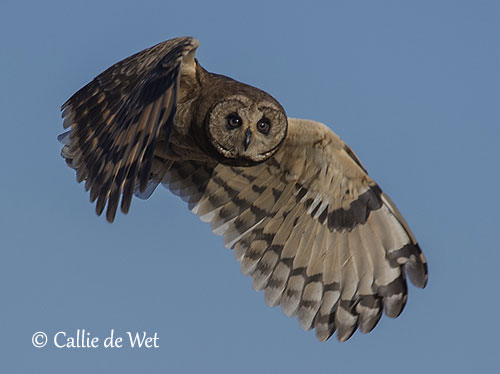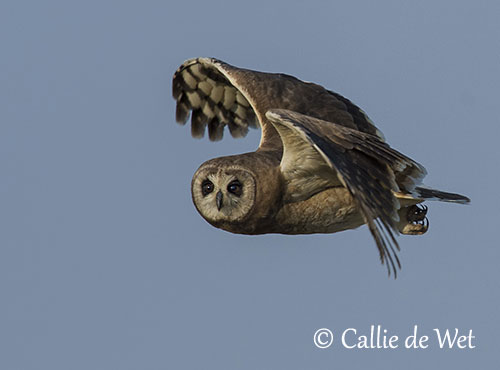
Fr: Hibou du Cap
Ang: Marsh Owl
All: Kapohreule
Esp: Búho Moro
Ita: Gufo di palude africano
Sd: kapuggla
Photographer:
Callie de Wet
GALLERY
Text by Nicole Bouglouan
Sources:
HANDBOOK OF THE BIRDS OF THE WORLD Vol 5 by Josep del Hoyo-Andrew Elliott-Jordi Sargatal - Lynx Edicions - ISBN: 8487334253
OWLS OF THE WORLD – By Claus König, Friedhelm Weick and Jan-Hendrik Becking - IBSN 978-0-7136-6548-2
BIRDS OF PREY OF AFRICA AND ITS ISLANDS by Alan and Meg Kemp - Struik Publishers - ISBN: 1770073698
BIRDS OF AFRICA SOUTH OF THE SAHARA by Ian Sinclair and Peter Ryan - Princeton University Press Princeton and Oxford - ISBN: 0691118159
BIRDS OF THE GAMBIA AND SENEGAL by Clive Barlow and Tim Wacher – Helm Field guides – ISBN: 0713675497
LES OISEAUX D’EUROPE ET D’AFRIQUE DU NORD par Hermann Heinzel, Richard Fitter, John Parslow - Delachaux Niestlé - Isbn : 2603014862
Wikipedia, the free encyclopaedia
How to save the Moroccan Marsh Owl from extinction? By MaghrebOrnitho
Marsh Owl
Asio capensis
Strigiformes Order – Strigidae Family
INTRODUCTION:
The Marsh Owl is a member of the subfamily Asioninae that includes medium-sized “eared-owls”. This species frequents grassland and marshland throughout much of the sub-Saharan Africa. It is very similar, both ecologically and morphologically, to the Short-eared Owl of which it is probably the closest relative.
It usually hunts during the day and at dusk, mainly on the wing, searching for insects and small vertebrates. The prey are often stored in “caches” for later consumption. It roosts and nests on the ground, among grasses and reeds in marshes.
The Marsh Owl is threatened by habitat loss and the nests are sometimes destroyed by fires, trampling by cattle, flooding and predators. But currently, this species is not globally threatened.

DESCRIPTION OF THE BIRD:
Biometrics:
Length: 29-36 cm
Wingspan: 82-99 cm
Weight: 225-375 g
The Marsh Owl is a plain brown, medium-sized owl with rounded head and small ear-tufts. It differs from the Short-eared Owl by the plain (not streaked) body and wing-coverts. On the upperwing, the outer primaries show buff patches, whereas the secondaries are mostly dark with buffy edges. The trailing edge is white. The tail has buff bars and white terminal band.
The underparts are barred with dark brown. We can see a dark carpal patch on the underwing. The tail is barred dark brown and white.
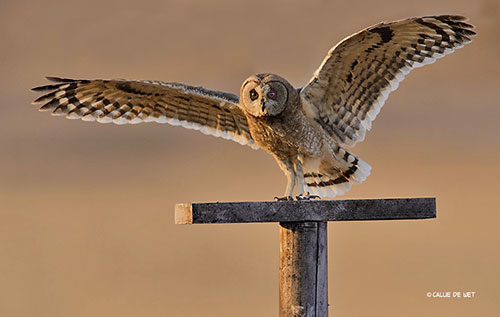
On the head, the facial disk is buff-coloured with dark areas around the eyes. The ear-tufts are inconspicuous.
The greyish bill has black tip. The eyes are dark brown. On the legs, the tarsi are feathered pale buff and the toes are covered with pale buffy-white feathers. Only the dark tips of the toes are bare. The talons are blackish.
Male and female have similar appearance, but the female is larger and darker than male.
The juvenile has a darker facial disk, outlined in black.
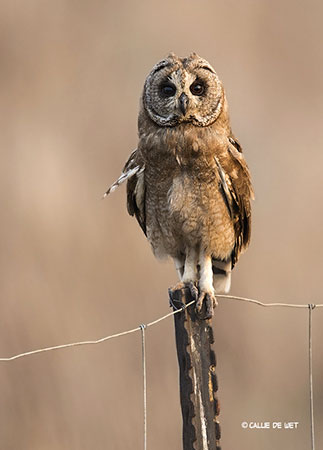
SUBSPECIES AND RANGE:
The Marsh Owl has three subspecies.
A.c. tinginatus is found in NW Morocco. It is darker than nominate, with rufous markings, mainly on the whitish underparts.
This race is restricted to a few remaining sites along the Atlantic coast and the population is very fragmented. The main cause of decline is the loss of the habitat and human disturbances.
A.c. capensis (described above and displayed on this page) is found in isolated areas in W Africa from Senegal to Chad and Cameroon, also from South Sudan and Ethiopian Highlands, and from S Congo and S DRCongo, to Namibia, N Botswana and much of South Africa (S to the Cape).
A.c. hova is found in Madagascar. This race is larger, with more distinct barring overall.
HABITAT:
The Marsh Owl frequents mostly marshes, but it is also seen in damp tall grassland, reeds, sedges and Acacia woodland.
It can be found too in estuarines marshes, mangroves, open savanna and cultivated areas. It selects the habitat according to seasonal fluctuations in rainfall and water levels.
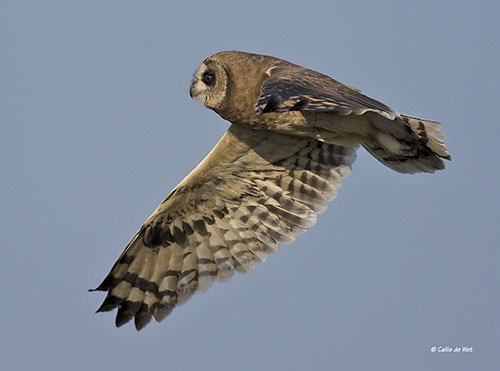
CALLS AND SONGS: SOUNDS BY XENO-CANTO
The Marsh Owl gives harsh, rasping “krikkk-krikkk” resembling the noise produced by breaking a dry branch very slowly. This call is repeated at variable intervals. When the owl is flying, it gives some croaking, raven-like calls “quark-quarrk-quarrk”, and a loud “creeeouw”.
BEHAVIOUR IN THE WILD:
The Marsh Owl feeds on insects and a variety of invertebrates and small vertebrates such as small mammals (rodents, young hares), but also birds, frogs and lizards. Insects include scorpions, beetles and termites.
It hunts mainly on the wing, flying low over the ground while searching for prey. It may occasionally hover or change abruptly of direction. Once the prey is detected, it dives to the ground and picks it up with the talons. Food items are often stored in concealed places for later consumption.
The Marsh Owl often hunts during the day, but also at night, before and after the sunset. Its acute eyesight allows it to detect the prey on the ground.
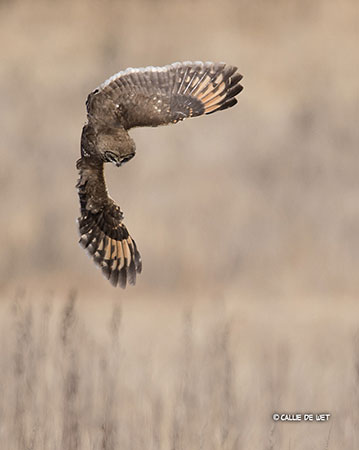
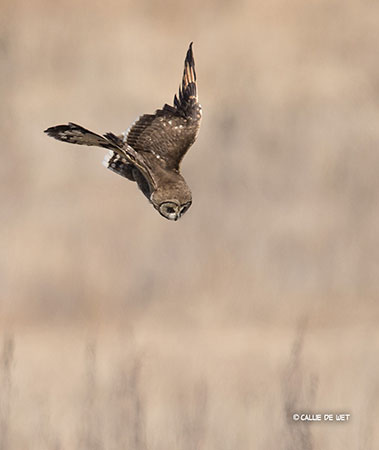
At the beginning of the breeding season, the male performs aerial displays at dusk, in order to claim the territory. It flies high with deep wingbeats, clapping the wings below its body.
During the nesting period, the female incubates alone but the male does all the hunting and feeds her at nest. They are monogamous and territorial, and they defend a territory.
Outside the breeding season, they may roost in groups of 15-30 individuals, but sometimes up to 100 birds together among grasses.
The Marsh Owl is partially migratory and may wander outside the breeding season. It leaves some areas during the wet season. It becomes nomadic when its habitat is destroyed by fires or drought. Some vagrants are reported in Spain, Portugal and Canary Islands.
The Marsh Owl has long wings, allowing it to glide slowly on stiff wings while searching for prey. It flies low over the ground with slow, powerful wingbeats interspersed with fast turns and hovering.
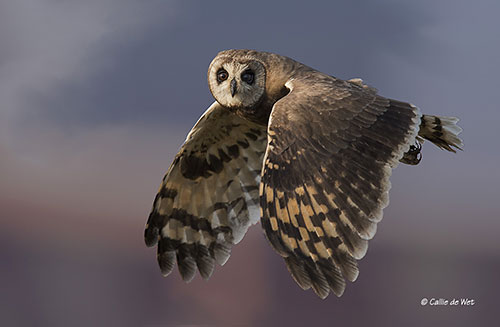
REPRODUCTION OF THIS SPECIES:
The breeding season varies according to the range, and takes place between February and October in N Africa with peak in March, and in September/November in SW Africa.
The Marsh Owl nests on the ground in a slight depression lined with dry leaves, among grasses and weeds. There is a lateral short grassy tunnel, and sometimes a vegetal dome. Such nest is usually difficult to find. They may nest sometimes in loose colonies.
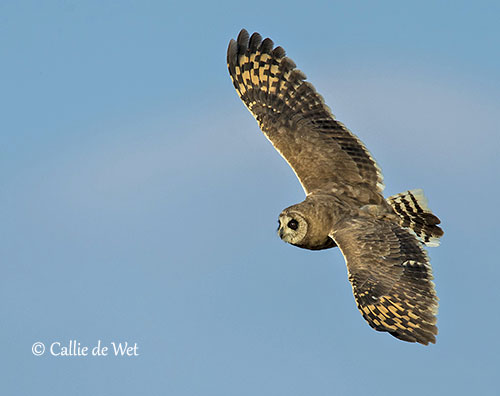
The female lays 2-4 whitish eggs, and incubates alone during 27-28 days while the male hunts and feeds her. It also stores food items in “caches” for later consumption by both mates.
The downy chicks remain at nest during 14-18 days and are brooded by the female. They start to crawl around the surrounding vegetation for a few weeks. They are fed by both parents. They fledge 35 days after hatching and are fully feathered at 70 days old. They are independent a month later.
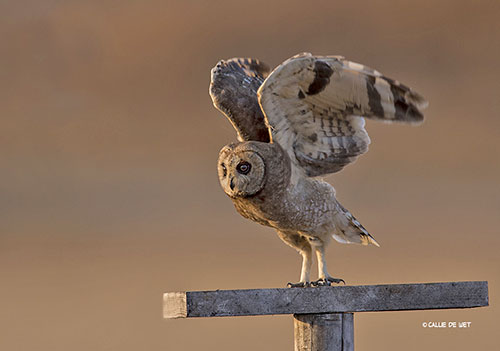
PROTECTION / THREATS / STATUS:
The Marsh Owl of nominate race is found in suitable habitats, and it is present in numerous protected areas. The race “tingitanus” has become rare due to habitat changes and human disturbance. The race “hova” is uncommon and irregularly distributed.
This species is threatened by habitat loss through fires, degradation by grazing and harvesting material. The nests are destroyed by fire, cattle, flooding and predators, and the adults are killed by traffic.
The global population has not been quantified, but it is suspected to be stable.
The Marsh Owl is currently evaluated as Least Concern.
